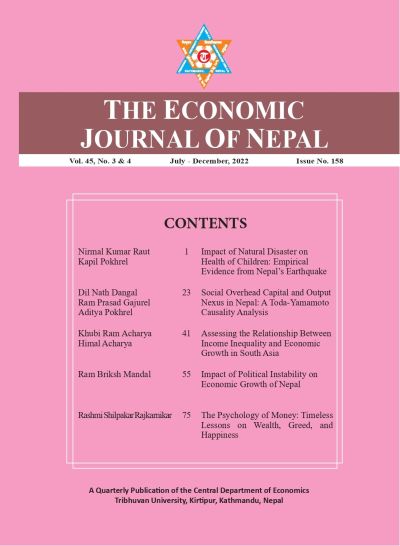Social Overhead Capital and Output Nexus in Nepal: A Toda-Yamamoto Causality Analysis
DOI:
https://doi.org/10.3126/ejon.v45i3-4.63146Keywords:
Social overhead capital, Output, Causality, Toda- Yamamoto, VARAbstract
Social overhead capital (SOC) is complementary to increasing productivity, particularly when the economy is also experiencing technological progress, thus spurring economies of scale and spillover effects. In its absence, the objective of developing nations to increase national output may be difficult to achieve. Such logjams are also found in Nepal. The objective of the study is to explore and evaluate the causal relationship between SOC and national output using VAR (k + dmax) based on the Toda-Yamamoto Granger no-causality test. The study uses the time series data of 36 years from 1986 to 2021. Nominal GDP is the dependent variable used to represent national output. Similarly, energy, road, telephone, vehicle, irrigation, gross fixed capital formation, health, and student enrollment in higher education are the independent variables used to represent SOC. The study found that roads, telephones, vehicles, and irrigation cause the NGDP, whereas overall SOC variables also caused the NGDP at a one percent significance level. It is also found that NGDP causes the energy, telephone, and enrollment of students in higher education. The study concluded that there is a significant causal nexus between SOC and NGDP directly or indirectly. The study underscores the vital need for the government of Nepal and policymakers to take measures to increase the national output and productivity. This means significantly strengthening key sectors like energy, infrastructure, healthcare, and higher education enrollment and promoting fixed capital formation.
Downloads
Downloads
Published
How to Cite
Issue
Section
License
© Cedecon-TU




